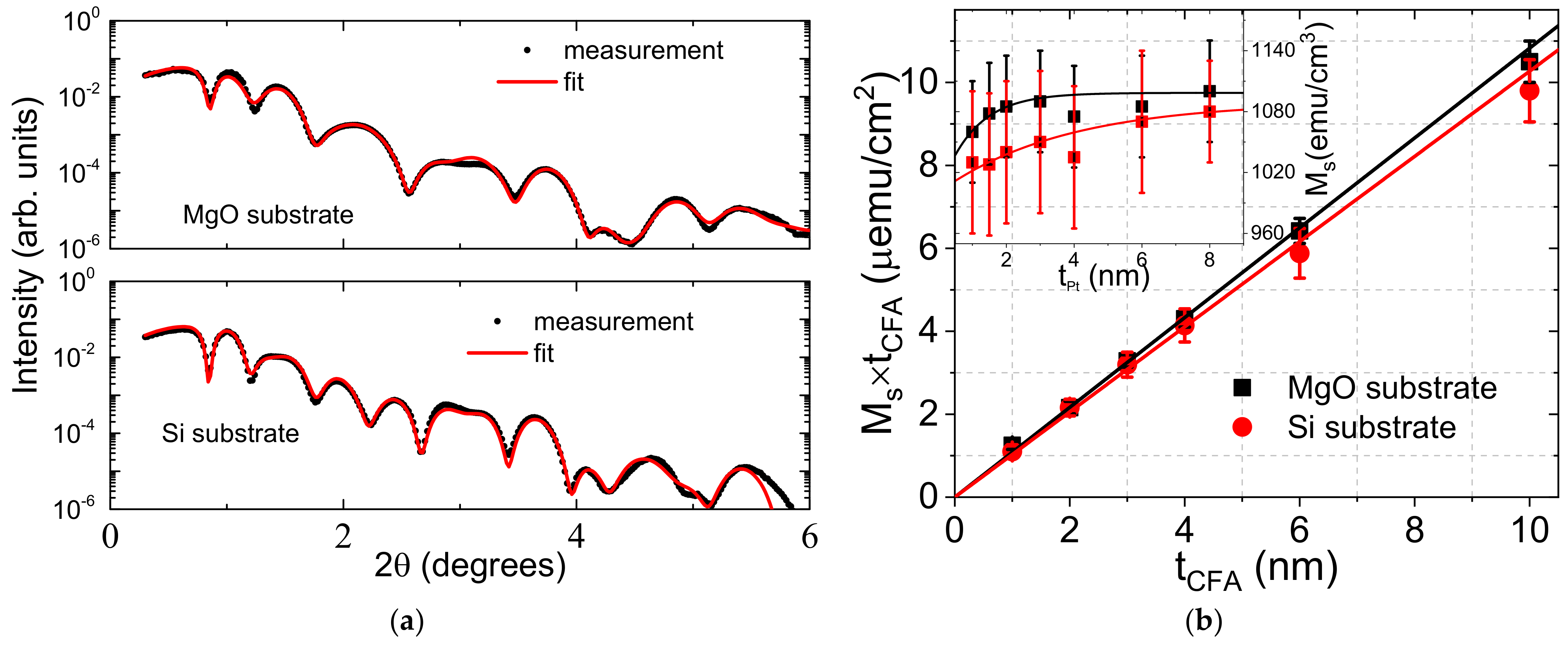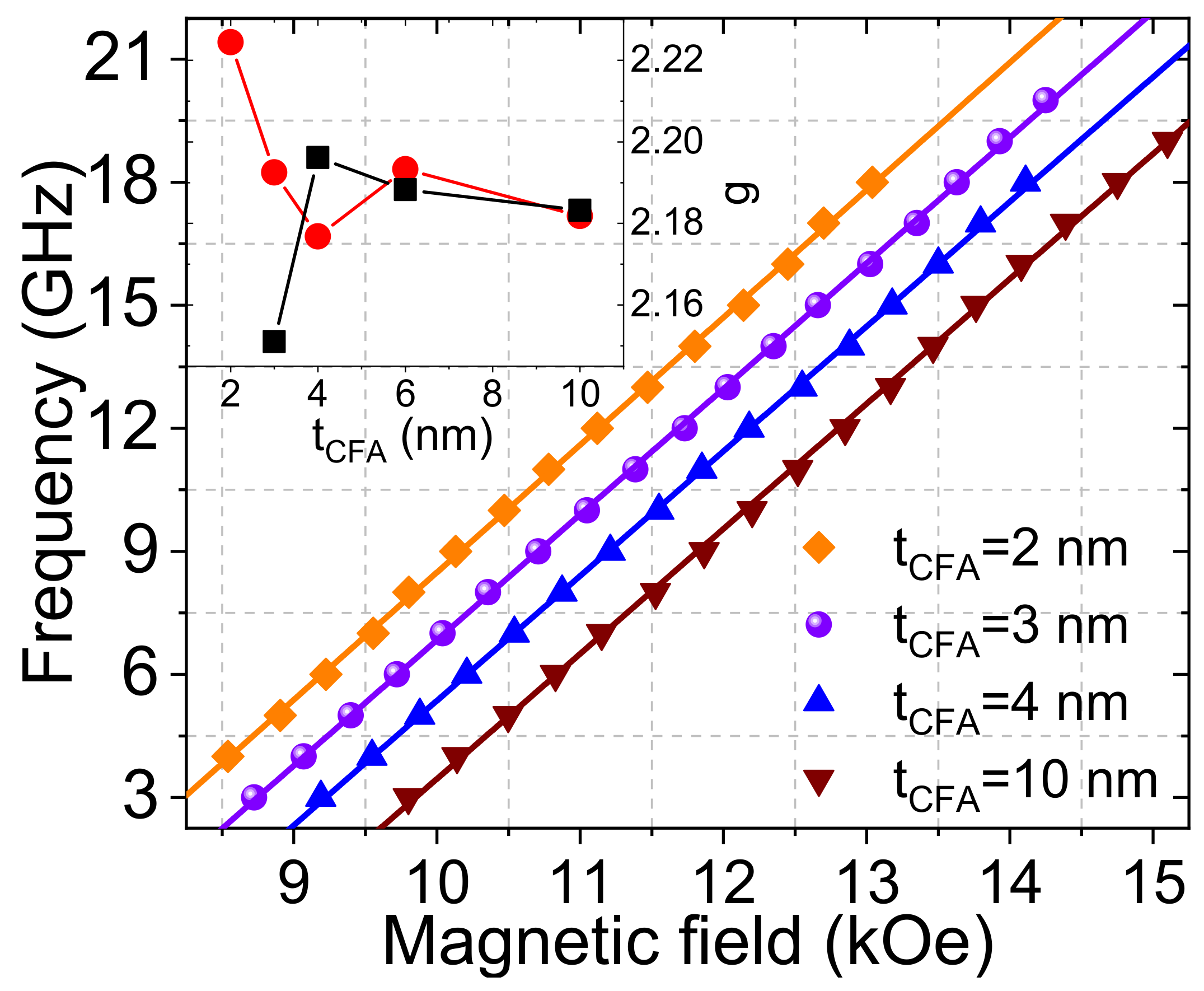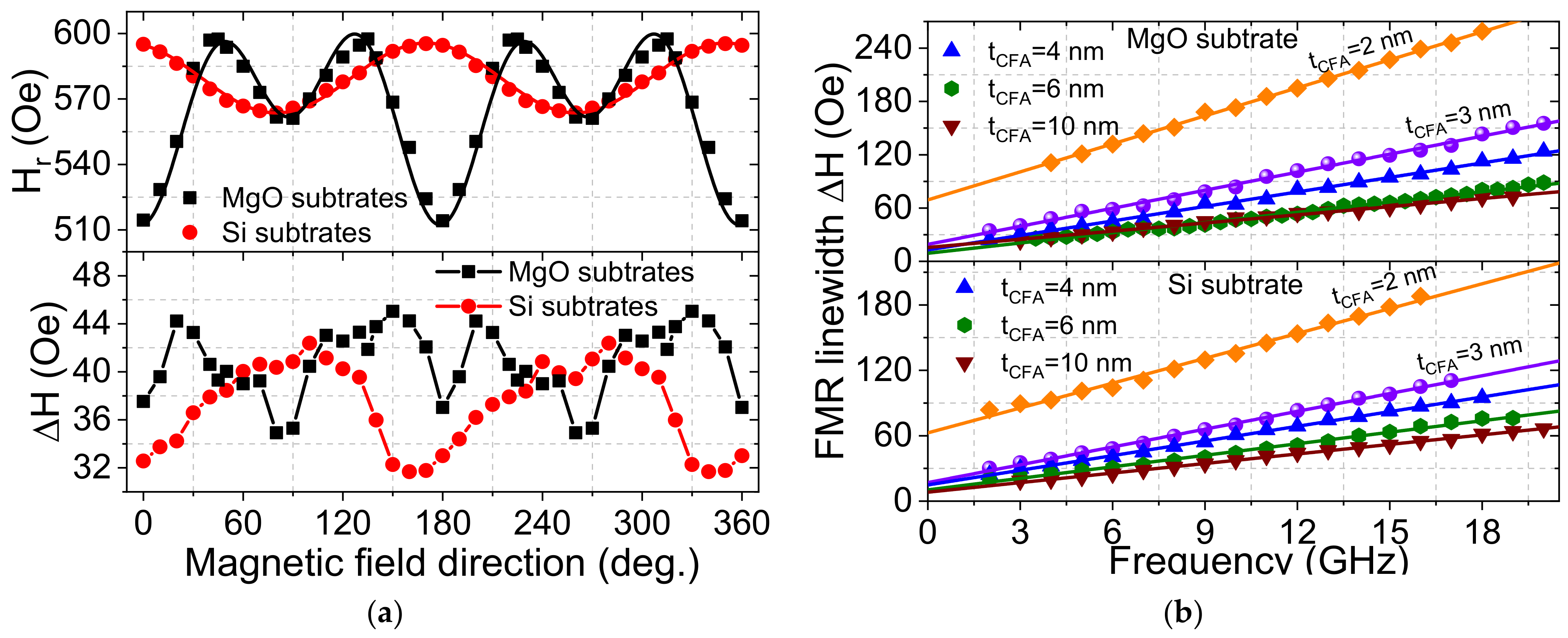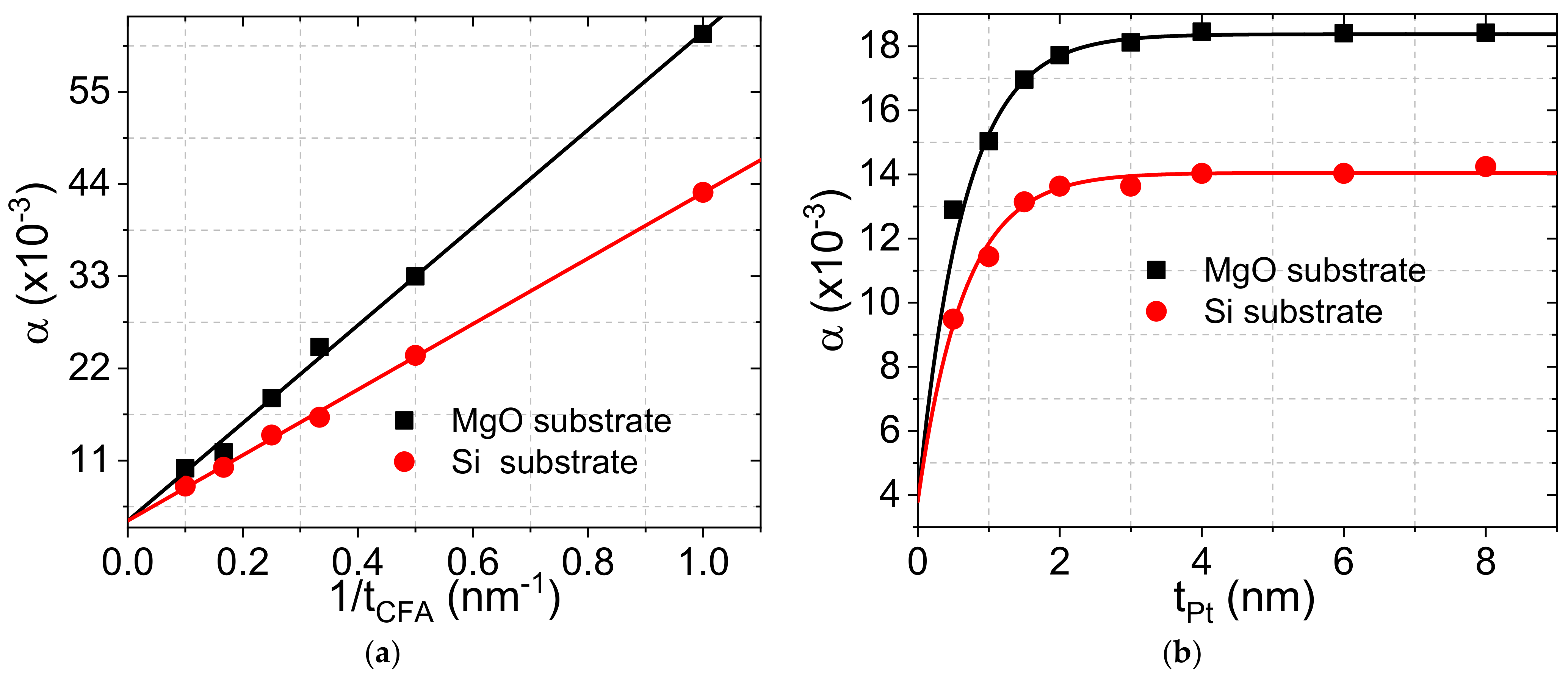Magnetic Damping and Dzyaloshinskii–Moriya Interactions in Pt/Co2FeAl/MgO Systems Grown on Si and MgO Substrates
Abstract
1. Introduction
2. Samples and Methods
3. Results and Discussion
3.1. Structural and Static Magnetic Properties
3.2. Gyromagnetic Ratio
3.3. Magnetic Damping
3.4. iDMI
4. Conclusions
Author Contributions
Funding
Data Availability Statement
Conflicts of Interest
References
- Marrows, C.H.; Hickey, B.J. New directions in spintronics. Phil. Trans. R. Soc. A 2011, 369, 3027. [Google Scholar] [CrossRef]
- Myers, E.B.; Ralph, D.C.; Katine, J.A.; Louie, R.N.; Buhrman, R.A. Current-induced switching of domains in magnetic multilayer devices. Science 1999, 285, 867. [Google Scholar] [CrossRef]
- Capua, A.; Yang, S.-H.; Phung, T.; Parkin, S.S.P. Determination of intrinsic damping of perpendicularly magnetized ultrathin films from time-resolved precessional magnetization measurements. Phys. Rev. B 2015, 92, 224402. [Google Scholar] [CrossRef]
- Lepadatu, S. Effect of inter-layer spin diffusion on skyrmion motion in magnetic multilayers. Sci. Rep. 2019, 9, 9592. [Google Scholar] [CrossRef]
- Kruglyak, V.V.; Demokritov, S.O.; Grundler, D. Magnonics. J. Phys. D 2010, 43, 264001. [Google Scholar] [CrossRef]
- Hirohata, A.C.; Lloyd, D.C. Heusler alloys for metal spintronics. MRS Bull. 2022, 47, 593. [Google Scholar] [CrossRef]
- Mizukami, S.; Watanabe, D.; Oogane, M.; Ando, Y.; Miura, Y.; Shirai, M.; Miyazaki, T. Low damping constant for Co2FeAl Heusler alloy films and its correlation with density of states. J. Appl. Phys. 2009, 105, 07D306. [Google Scholar] [CrossRef]
- Dürrenfeld, P.; Gerhard, F.; Chico, J.; Dumas, R.K.; Ranjbar, M.; Bergman, A.; Bergqvist, L.; Delin, A.; Gould, C.; Molenkamp, L.W.; et al. Tunable damping, saturation magnetization, and exchange stiffness of half-Heusler NiMnSb thin films. J. Phys. Rev. B 2015, 92, 214424. [Google Scholar] [CrossRef]
- Schoen, M.A.W.; Thonig, D.; Schneider, M.L.; Silva, T.J.; Nembach, H.T.; Eriksson, O.; Karis, O.; Shaw, J.M. Ultra-Low magnetic damping of a metallic ferromagnet. Nat. Phys. 2016, 12, 839. [Google Scholar] [CrossRef]
- Arora, M.; Delczeg-Czirjak, E.K.; Riley, G.; Silva, T.J.; Nembach, H.T.; Eriksson, O.; Shaw, J.M. Magnetic Damping in Polycrystalline Thin-Film Fe-V Alloys. Phys. Rev. App. 2021, 15, 054031. [Google Scholar] [CrossRef]
- Elphicka, K.; Frosta, W.; Samiepoura, M.; Kubotab, T.; Takanashib, K.; Sukegawae, H.; Mitanie, S.; Hirohata, A. Heusler alloys for spintronic devices: Review on recent development and future perspectives. Sci. Technol. Adv. Mater. 2021, 22, 236. [Google Scholar] [CrossRef] [PubMed]
- Sinova, J.; Valenzuela, S.O.; Wunderlich, J.; Back, C.H.; Jungwirth, T. Spin Hall effects. Rev. Mod. Phys. 2015, 87, 1213. [Google Scholar] [CrossRef]
- Fert, A. Magnetic and transport properties of metallic multilayers. Mater. Sci. Forum 1990, 59, 439. [Google Scholar] [CrossRef]
- Tserkovnyak, Y.; Brataas, A.; Bauer, G.E.W. Spin pumping and magnetization dynamics in metallic multilayers. Phys. Rev. B 2002, 66, 224403. [Google Scholar] [CrossRef]
- Saitoh, E.; Ueda, M.; Miyajima, H. Conversion of spin current into charge current at room temperature: Inverse spin-Hall effect. Appl. Phys. Lett. 2006, 88, 182509. [Google Scholar] [CrossRef]
- Garello, K.; Avci, C.O.; Miron, I.M.; Baumgartner, M.; Ghosh, A.; Auffret, S.; Boulle, O.; Gaudin, G.; Gambardella, P. Ultrafast magnetization switching by spin-orbit torques. Appl. Phys. Lett. 2014, 105, 212402. [Google Scholar] [CrossRef]
- Gabor, M.S.; Petrisor, T., Jr.; Nasui, M.; Nsibi, M.A.; Nath, J.; Miron, I.M. Spin-orbit torques and magnetization switching in perpendicularly magnetized epitaxial Pd/Co2FeAl/MgO structures. Phys. Rev. Appl. 2020, 13, 054039. [Google Scholar] [CrossRef]
- Belmeguenai, M.; Gabor, M.S.; Zighem, F.; Challab, N.; Petrisor, T., Jr.; Mos, R.B.; Tiusan, C. Ferromagnetic-resonance-induced spin pumping in Co20Fe60B20/Pt systems: Damping investigation. J. Phys. D Appl. Phys. 2018, 51, 045002. [Google Scholar] [CrossRef]
- Belmeguenai, M.; Gabor, M.S.; Roussigné, Y.; Stashkevich, A.; Chérif, S.M.; Zighem, F.; Tiusan, C. Brillouin light scattering investigation of the thickness dependence of Dzyaloshinskii-Moriya interaction in Co0.5Fe0.5 ultrathin films. Phys. Rev. B 2016, 93, 174407. [Google Scholar] [CrossRef]
- Belmeguenai, M.; Tuzcuoglu, H.; Gabor, M.S.; Petrisor, T., Jr.; Tiusan, C.; Berling, D.; Zighem, F.; Chauveau, T.; Chérif, S.M.; Moch, P. Co2FeAl thin films grown on MgO substrates: Correlation between static, dynamic and structural properties. Phys. Rev. B 2013, 87, 184431. [Google Scholar] [CrossRef]
- Belmeguenai, M.; Tuzcuoglu, H.; Gabor, M.S.; Petrisor, T., Jr.; Tiusan, C.; Zighem, F.; Chérif, S.M.; Moch, P. Co2FeAl Heusler thin films grown on Si and MgO substrates: Annealing temperature effect. J. Appl. Phys. 2014, 115, 043918. [Google Scholar] [CrossRef]
- Belmeguenai, M.; Tuzcuoglu, H.; Gabor, M.S.; Petrisor, T.; Tiusan, C.; Berling, D.; Zighem, F.; Chérif, S.M. Magnetic and structural properties of Co2FeAl thin films grown on Si substrate. J. Magn. Magn. Mater. 2015, 373, 140. [Google Scholar] [CrossRef][Green Version]
- Belmeguenai, M.; Gabor, M.S.; Zighem, F.; Roussigné, Y.; Faurie, D.; Tiusan, C. Annealing temperature and thickness dependencies of structural and magnetic properties of Co2FeAl thin films. Phys. Rev. B 2016, 94, 104424. [Google Scholar] [CrossRef]
- Caminale, M.; Ghosh, A.; Auffret, S.; Ebels, U.; Ollefs, K.; Wilhelm, F.; Rogalev, A.; Bailey, W.E. Spin pumping damping and magnetic proximity effect in Pd and Pt spin-sink layers. Phys. Rev. B 2016, 94, 014414. [Google Scholar] [CrossRef]
- Li, Y.; Zeng, F.; Zhang, S.S.-L.; Shin, H.; Saglam, H.; Karakas, V.; Ozatay, O.; Pearson, J.E.; Heinonen, O.G.; Wu, Y.; et al. Giant Anisotropy of Gilbert Damping in Epitaxial CoFe Films. Phys. Rev. Lett. 2019, 122, 117203. [Google Scholar] [CrossRef]
- Ourdani, D.; Roussigné, Y.; Chérif, S.M.; Gabor, M.S.; Belmeguenai, M. Correlation between interface perpendicular magnetic anisotropy and interfacial Dzyaloshinskii–Moriya interactions in Pt/Pd(tPd)/Co(tCo)/Au. J. Phys. D Appl. Phys. 2022, 55, 485004. [Google Scholar] [CrossRef]
- Belmeguenai, M.; Roussigné, Y.; Bouloussa, H.; Chérif, M.S.; Stashkevich, A.; Nasui, M.; Gabor, S.M.; Mora-Hernández, A.; Nicholson, B.; Inyang, O.-O.; et al. Thickness dependence of the Dzyaloshinskii-Moriya interaction in Co2FeAl Ultrathin films: Effects of annealing temperature and heavy-metal material. Phys. Rev. Appl. 2018, 9, 044044. [Google Scholar] [CrossRef]
- Gladii, O.; Haidar, M.; Henry, Y.; Kostylev, M.; Bailleul, M. Frequency nonreciprocity of surface spin wave in permalloy thin films. Phys. Rev. B 2016, 93, 054430. [Google Scholar] [CrossRef]
- Kim, N.-H.; Han, D.-S.; Jung, D.; Park, K.; Swagten, H.J.M.; Kim, J.-S.; You, C.-Y. Dependence of interfacial Dzyaloshinskii–Moriya interaction and perpendicular magnetic anisotropy on the thickness of the heavy-metal layer. Appl. Phys. Express 2017, 10, 103003. [Google Scholar] [CrossRef]





Disclaimer/Publisher’s Note: The statements, opinions and data contained in all publications are solely those of the individual author(s) and contributor(s) and not of MDPI and/or the editor(s). MDPI and/or the editor(s) disclaim responsibility for any injury to people or property resulting from any ideas, methods, instructions or products referred to in the content. |
© 2023 by the authors. Licensee MDPI, Basel, Switzerland. This article is an open access article distributed under the terms and conditions of the Creative Commons Attribution (CC BY) license (https://creativecommons.org/licenses/by/4.0/).
Share and Cite
Challab, N.; Roussigné, Y.; Chérif, S.M.; Gabor, M.; Belmeguenai, M. Magnetic Damping and Dzyaloshinskii–Moriya Interactions in Pt/Co2FeAl/MgO Systems Grown on Si and MgO Substrates. Materials 2023, 16, 1388. https://doi.org/10.3390/ma16041388
Challab N, Roussigné Y, Chérif SM, Gabor M, Belmeguenai M. Magnetic Damping and Dzyaloshinskii–Moriya Interactions in Pt/Co2FeAl/MgO Systems Grown on Si and MgO Substrates. Materials. 2023; 16(4):1388. https://doi.org/10.3390/ma16041388
Chicago/Turabian StyleChallab, Nabil, Yves Roussigné, Salim Mourad Chérif, Mihai Gabor, and Mohamed Belmeguenai. 2023. "Magnetic Damping and Dzyaloshinskii–Moriya Interactions in Pt/Co2FeAl/MgO Systems Grown on Si and MgO Substrates" Materials 16, no. 4: 1388. https://doi.org/10.3390/ma16041388
APA StyleChallab, N., Roussigné, Y., Chérif, S. M., Gabor, M., & Belmeguenai, M. (2023). Magnetic Damping and Dzyaloshinskii–Moriya Interactions in Pt/Co2FeAl/MgO Systems Grown on Si and MgO Substrates. Materials, 16(4), 1388. https://doi.org/10.3390/ma16041388




